This guide provides essential insights into Subaru parts compatibility, helping owners and enthusiasts identify interchangeable components across models. It covers engines, transmissions, suspension, and more, ensuring cost-effective solutions while maintaining performance and reliability.
Understanding the Importance of Parts Interchangeability
Understanding parts interchangeability is crucial for Subaru owners and enthusiasts, as it enables cost-effective repairs and upgrades. By identifying compatible components across models, drivers can avoid costly OEM parts and extend their vehicle’s lifespan. Interchangeable parts also simplify maintenance, allowing owners to source replacements quickly. This approach reduces downtime and ensures optimal performance. Additionally, swapping parts fosters a sense of community, as enthusiasts share knowledge and resources. Proper compatibility ensures safety and reliability, preventing potential mechanical failures. By leveraging interchangeable parts, Subaru owners can customize their vehicles while maintaining factory standards. This guide provides a comprehensive overview, helping users make informed decisions for their Subaru projects.
Overview of Subaru’s Engine and Transmission Compatibility
Subaru’s engine and transmission compatibility varies across models but offers significant opportunities for interchange. The iconic boxer engine design and symmetric all-wheel-drive system provide a foundation for parts swapping. Many engines, such as the 2.5L and 3.6L, share compatibility across models like the Forester, Impreza, and Legacy. Transmissions, including manual and CVT options, also show interchange potential, though clutch and wiring harness compatibility must be verified. Proper matching ensures smooth integration and maintains performance. This compatibility allows owners to upgrade or repair their vehicles cost-effectively. Consulting Subaru’s official parts catalog or enthusiast communities can provide detailed insights for successful swaps.
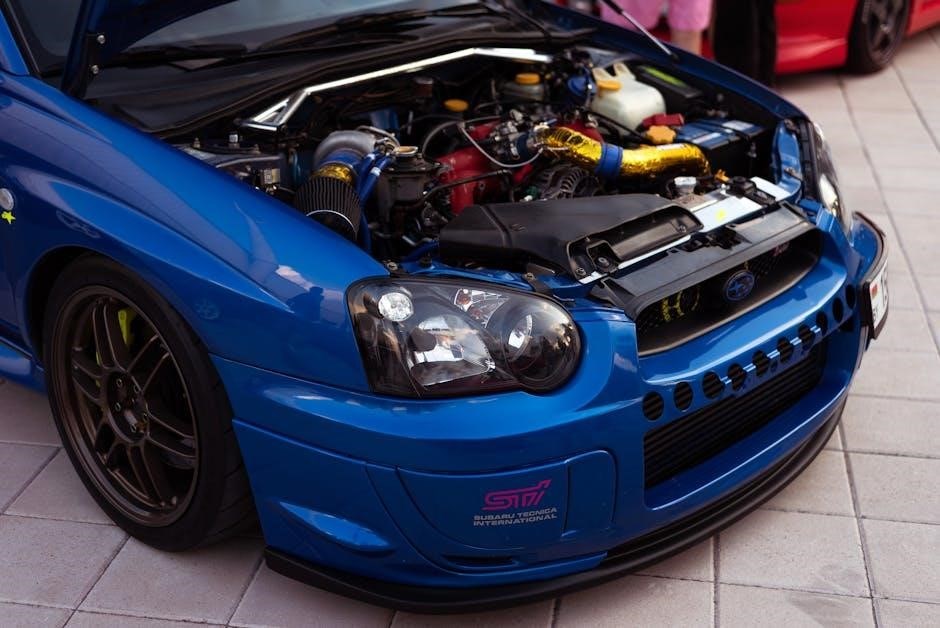
Subaru Model-Specific Parts Interchange Guide
This section provides detailed insights into parts interchangeability across Subaru models, including Forester, Impreza, Legacy, and WRX/STI. It helps enthusiasts and owners identify compatible components for upgrades or repairs.
Forester Parts Interchange
The Subaru Forester, known for its versatility, shares many parts with other Subaru models, particularly the Impreza and Legacy. Engines like the 2.5L Boxer are often interchangeable across generations, while transmissions may require specific matching due to electronic controls. Suspension and braking components also show compatibility, especially between Forester and Impreza models. However, electrical systems, such as ECUs and wiring harnesses, must be carefully matched to avoid integration issues. Wheel and tire setups are generally consistent across similar model years. When swapping parts, consulting repair manuals or community forums is crucial to ensure compatibility. This guide helps Forester owners identify interchangeable parts, enabling cost-effective upgrades and repairs while maintaining performance and reliability.
Impreza Parts Interchange
The Subaru Impreza is highly versatile in parts interchange, sharing components with models like the Forester and Legacy. Engines such as the 2.5L Boxer are commonly swapped across generations, while transmissions may require specific matching due to electronic controls. Suspension and braking systems often align with Forester parts, offering cost-effective upgrades. Interior and exterior trim components are frequently interchangeable with similar models, allowing for easy customization. Wheels and tires from the same generation typically fit without modifications. When swapping parts, consulting repair manuals or online forums is essential to ensure compatibility. This guide helps Impreza owners identify suitable parts, enabling efficient upgrades and repairs while maintaining performance and reliability.
Legacy Parts Interchange
The Subaru Legacy offers extensive parts interchange opportunities, particularly with the Outback and Forester. Engines like the 3.0L and 2.5L Boxer are often shared, while transmissions may need careful matching due to electronic controls. Suspension components, such as struts and control arms, are frequently compatible with other models, enabling upgrades without significant modifications. Brake systems, including rotors and calipers, also align with similar models, ensuring cost-effective replacements. Interior and exterior trim pieces can be swapped with ease, while wheels and tires from the same generation typically fit without issues. This guide helps Legacy owners identify interchangeable parts, facilitating efficient repairs and upgrades while maintaining performance and reliability. Proper planning and research are essential for successful swaps.
WRX/STI Parts Interchange
The Subaru WRX and STI are highly modifiable models, with significant parts interchange opportunities. Engines such as the EJ257 and EJ205 are widely swapped between WRX and STI variants, while transmissions like the 5-speed and 6-speed are often compatible with slight modifications. Suspension components, including coilovers and sway bars, are frequently shared across WRX/STI generations, enhancing handling and performance. Brake systems, such as Brembo calipers, can be interchanged with other high-performance Subaru models. Wheels and lightweight body panels are also interchangeable, offering aesthetic and functional upgrades. Electrical components like ECUs and wiring harnesses may require careful matching, but exhaust systems and turbochargers are often compatible. These swaps enable enthusiasts to enhance performance while maintaining reliability, making the WRX/STI a favorite for tuning and customization.
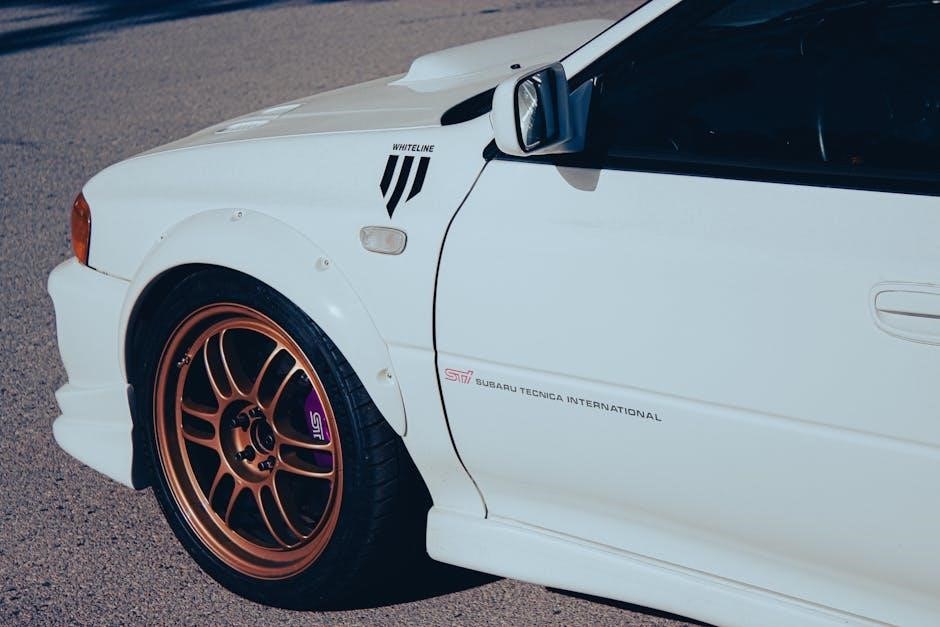
Engine and Transmission Interchange
Subaru engines and transmissions are highly interchangeable, with the Boxer engine’s compact design allowing compatibility across models. Always ensure clutch and ECU compatibility for seamless swaps.
Subaru Boxer Engine Interchange Guide
Subaru’s Boxer engine, known for its horizontal design, offers significant interchange potential across models. Compatibility depends on engine codes (e.g., EJ20, EJ25) and model years. While some engines are plug-and-play, others require modifications to wiring, ECUs, or mounts. Always verify VIN and engine specs for a smooth swap. Common swaps include EJ series engines between Impreza, Legacy, and Forester models. Ensure compatibility with transmission and drivetrain components. For reliability, use genuine Subaru parts or trusted aftermarket alternatives. Consulting forums and repair manuals is highly recommended to avoid costly mistakes. Proper installation ensures optimal performance and longevity of your Subaru.
Transmission Compatibility Across Subaru Models
Subaru transmissions vary in compatibility depending on model and year. The 5-speed manual is often interchangeable across Impreza, Forester, and Legacy models, while 6-speed transmissions are more specific to performance models like WRX/STI. CVT transmissions, common in newer Subarus, are less interchangeable due to model-specific programming. Always match transmission codes and drivetrain configurations. For example, AWD transmissions are distinct from RWD variants. Verify compatibility using VIN or part numbers to ensure proper fitment. Swapping transmissions may require ECU recalibration and clutch upgrades. Consult repair manuals or forums for model-specific guidance. Proper alignment with engine and drivetrain ensures smooth operation and prevents damage. Research thoroughly to avoid costly mismatches.

Suspension and Braking System Interchange
Subaru suspension and braking components vary by model, but many parts are interchangeable. Struts, springs, and brake calipers often match across similar generations of Forester and Impreza. Ensure compatibility by verifying part numbers and model-specific configurations to maintain optimal performance and safety.
Front Suspension Components Interchange
Front suspension components in Subaru models often share compatibility across similar generations. For instance, struts and springs from the Forester can sometimes fit the Impreza, especially within the same model years. Control arms and steering racks also show interchangeability, particularly between the Legacy and Outback. However, precise fitment depends on the specific model year and generation. It’s crucial to verify part numbers and cross-reference with Subaru’s official documentation or trusted aftermarket sources. While some components may physically bolt on, ensure they maintain proper alignment and functionality. Always test compatibility before final installation to avoid misalignment or performance issues. Consulting online forums or professional mechanics can provide valuable insights for a successful swap.
Rear Suspension Components Interchange
Subaru rear suspension components, such as trailing arms, springs, and dampers, often show interchangeability across similar models. For example, the rear subframe from a 2019 Forester can sometimes fit a 2020 Outback, provided the model years and drivetrain configurations align. Coil springs and shock absorbers may also be swapped between the Legacy and Impreza, though ride height and stiffness must match. When swapping, ensure compatibility by cross-referencing part numbers or consulting repair manuals. Improper installation can lead to misalignment or reduced handling performance. Always verify fitment before installation, as subtle differences in design can affect overall functionality. Online forums and Subaru-specific communities often provide firsthand experiences and guidance for successful rear suspension swaps.
Brake System Compatibility
Subaru brake systems, including rotors, calipers, and pads, often show compatibility across similar models due to shared design principles. For instance, the front brake rotors from a 2018 Forester may fit a 2019 Impreza, provided the wheel size and drivetrain match. Rear brake components, such as calipers and pads, can also be swapped between the Legacy and Outback, ensuring consistent braking performance. However, ABS sensors and electronic brake modules are typically model-specific and may require recalibration. Always verify part numbers and specifications before installation. Consulting Subaru repair manuals or online forums can provide insights into successful brake system swaps. Proper compatibility ensures safety and optimal braking performance, so thorough checks are essential before making any modifications.

Electrical and Electronic Components
Subaru’s ECUs, wiring harnesses, and sensors are often model-specific, requiring precise compatibility checks. Swapping these components demands careful calibration to ensure proper system function and avoid errors.
ECU and Wiring Harness Compatibility
ECU and wiring harness compatibility in Subaru models are critical for seamless parts interchange. The Engine Control Unit (ECU) is model-specific, requiring precise calibration to match the vehicle’s systems. Wiring harnesses must align with the ECU’s configuration to ensure proper communication. Mismatched components can lead to system malfunctions or errors. When swapping an ECU, it’s essential to reprogram it to the vehicle’s specifications using Subaru-specific tools. Additionally, the wiring harness should be inspected for compatibility to avoid electrical issues. Proper installation ensures optimal performance and reliability, making it crucial to consult factory guidelines or seek professional assistance for such interchanges.
Sensor and Electronic Module Interchange
Sensors and electronic modules in Subaru vehicles are highly model-specific, requiring careful consideration during interchange. Many sensors, such as those for temperature, pressure, and oxygen, are calibrated to work with specific ECU configurations. Swapping these components without proper compatibility can result in incorrect readings, error codes, or system failures. For example, crankshaft and camshaft position sensors must align with the engine’s firing sequence. Electronic modules, like ECMs and TCUs, often need reprogramming to function correctly in a different vehicle. Always verify compatibility and consult factory specifications or trusted resources before performing such swaps to ensure proper system operation and avoid costly repairs.
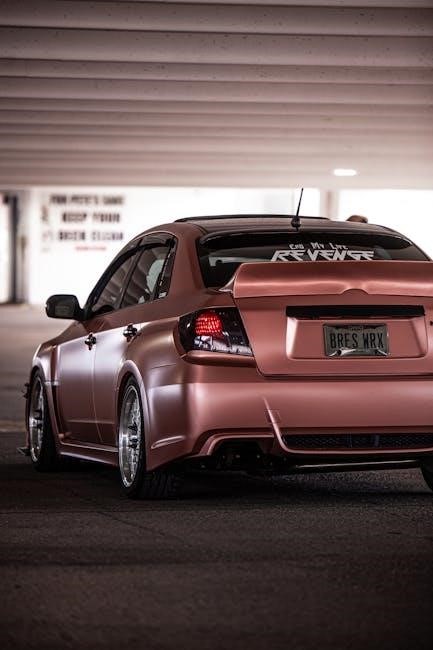
Accessories and Body Parts
Accessories and body parts play a crucial role in customizing and maintaining Subaru vehicles. Wheels, tires, and exterior trim often share compatibility across models, enhancing both aesthetics and functionality. Interior components like dash trims and seats may also interchange, depending on the generation. Ensuring proper fitment and compatibility is essential to preserve performance and safety. Always consult Subaru’s official guides or trusted communities for accurate information.
Interior and Exterior Trim Interchange
Interior and exterior trim components can often be interchanged between Subaru models, offering a cost-effective way to customize or repair your vehicle. Dash trim, door panels, and other interior pieces may share compatibility across similar generations of models like the Impreza, Forester, or Legacy. Exterior trim, such as bumpers, side moldings, and roof rails, can also be swapped, depending on the model year and design. However, subtle differences in dimensions or mounting points may require adjustments. Always verify compatibility using the Vehicle Identification Number (VIN) or consult Subaru’s official parts catalog. This ensures a proper fit and maintains the vehicle’s aesthetic and functional integrity. Online forums and communities are valuable resources for identifying interchangeable trim parts.
Wheel and Tire Compatibility
Wheel and tire compatibility across Subaru models depends on factors like bolt pattern, wheel diameter, and offset. Most Subaru models share a 5×100 bolt pattern, allowing wheels to be swapped between vehicles. However, variations in wheel offset and tire width can affect fitment and performance. Tires must match the vehicle’s specifications for size, load rating, and speed rating. For example, the Forester and Outback often share compatible wheels due to similar designs. Always consult the owner’s manual or manufacturer’s specifications to ensure proper fitment. Mismatched tires or wheels can compromise safety and handling. Online resources and Subaru communities provide valuable insights for selecting the right components for your vehicle, ensuring optimal performance and reliability.
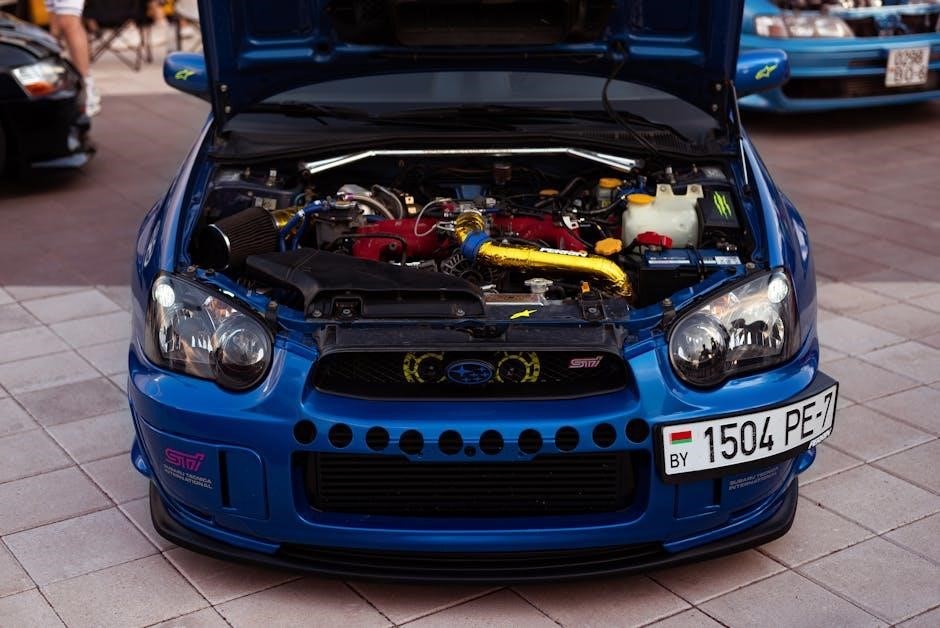
Tools and Resources for Parts Interchange
Eessential tools include a torque wrench, socket set, and scan tool for diagnosing issues. Online forums and Subaru-specific part catalogs provide invaluable resources for interchange projects.
Essential Tools for Swapping Subaru Parts
When swapping Subaru parts, having the right tools is crucial. A torque wrench ensures proper bolt tightening, while a socket set covers various bolt sizes. Pliers and punches are handy for removing clips and pins. A scan tool or OBD-II reader helps diagnose issues post-swap. Specialized tools like a timing chain tool may be needed for engine work. Workshop manuals and repair guides provide step-by-step instructions. Jack stands and a lift improve access, while a drain pan and gloves ensure safety. Online forums and Subaru communities offer valuable insights and troubleshooting tips, making them indispensable resources for any parts swap.
Online Resources and Communities
Online resources and communities are invaluable for Subaru parts interchange. Forums like NASIOC and Reddit’s r/Subaru offer extensive discussions and guides. Websites such as SubaruPartsOnline and OEM Subaru Parts provide detailed catalogs and compatibility charts. YouTube channels dedicated to Subaru modifications share hands-on experiences and tutorials. Facebook groups like Subaru Engine Swaps and Subaru Parts Exchange connect enthusiasts globally. These platforms allow users to ask questions, share knowledge, and find rare parts. Many communities also host DIY guides and troubleshooting tips, making them indispensable for anyone exploring parts interchange. By leveraging these resources, enthusiasts can ensure successful swaps and stay updated on the latest compatibility trends;
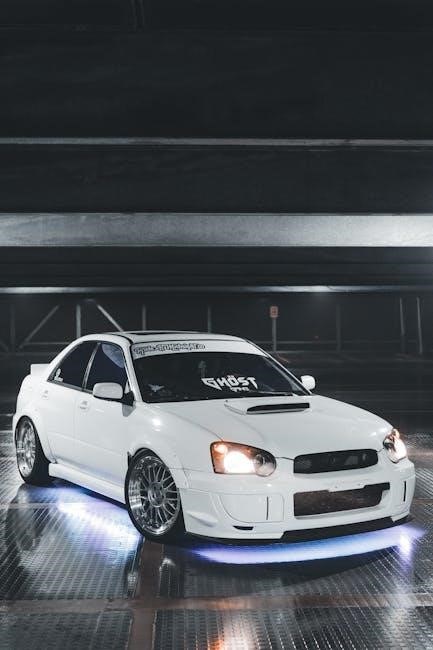
Safety and Legal Considerations
Ensure all parts swaps comply with local regulations and safety standards. Always use proper tools and follow manufacturer guidelines to avoid legal or safety issues.
Ensuring Safety During Parts Swaps
Safety is paramount when swapping Subaru parts. Always disconnect the battery before starting work to prevent electrical hazards. Use proper tools and follow manufacturer guidelines. Ensure all parts are compatible and properly installed to avoid mechanical failures. Consult repair manuals or online resources for specific instructions. Never compromise on critical components like brakes or suspension. If unsure, seek professional assistance to guarantee safety and reliability. Properly bleed brake systems and test drive cautiously after swaps. Keep emergency equipment handy and ensure a clean, well-lit workspace. Adhering to safety protocols protects both the vehicle and the technician.
Legal Implications of Parts Interchange
When swapping Subaru parts, it’s crucial to consider legal implications. Ensure all modifications comply with local regulations and safety standards. Using incompatible or non-approved parts may void warranties or violate emissions laws. Always verify parts compatibility using the Vehicle Identification Number (VIN) and consult Subaru’s guidelines. Non-OEM parts may affect insurance coverage or resale value. Certain modifications, such as engine swaps, might require inspections or certifications. Be aware of intellectual property rights when sourcing parts. Legal issues can arise if modifications compromise safety or emissions standards. Always follow manufacturer recommendations and local laws to avoid penalties or legal consequences. Proper documentation and compliance are essential for maintaining vehicle legitimacy and avoiding legal disputes.
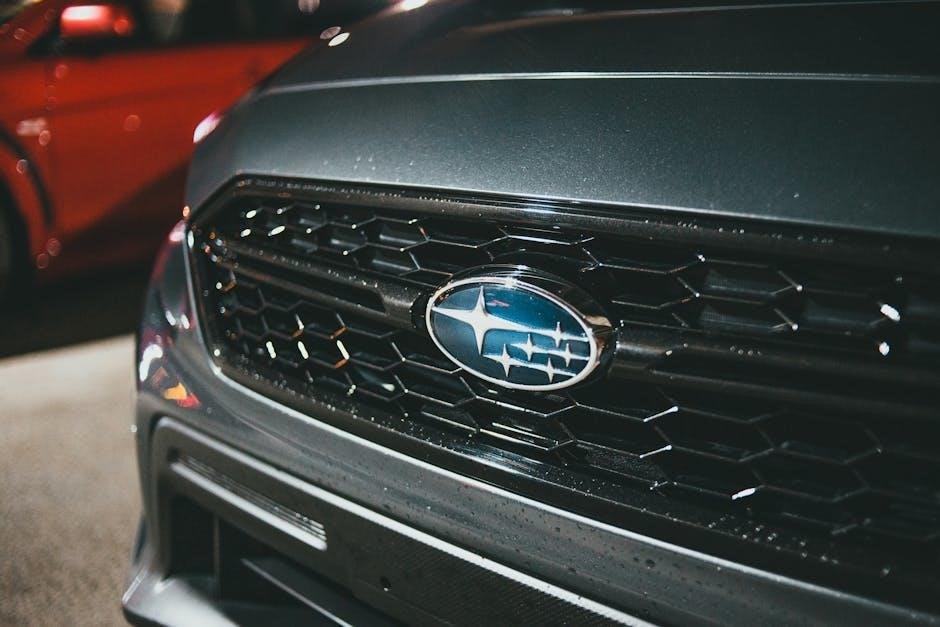
Case Studies and Real-World Examples
Explore real-world Subaru part swaps, such as successful engine exchanges and transmission upgrades, offering practical insights and lessons learned from enthusiasts and mechanics.
Successful Engine Swaps in Subaru Models
Subaru enthusiasts have achieved remarkable engine swaps, enhancing performance and reliability. The EJ series engines, such as the EJ20 and EJ25, are popular for swaps due to their compatibility across models like the Impreza and Forester. For instance, swapping a naturally aspirated EJ25 into a turbo-charged WRX chassis can deliver improved power. Ensure the engine’s VIN matches the recipient car for compatibility, and transfer sensors and wiring harnesses from the old engine. Resources like Subaru’s VIN decoder and community forums provide valuable insights. Successful swaps often involve meticulous planning and professional guidance to avoid costly errors. Always verify parts compatibility before starting a project to ensure seamless integration and optimal performance.
Transmission Swap Experiences
Transmission swaps in Subaru models have proven successful for enhancing performance and reliability. Many enthusiasts have swapped manual transmissions, such as the 5-speed from a 2006 Outback, into cars like the Impreza, achieving smoother shifting and better control. Key considerations include ensuring clutch compatibility and matching the transmission’s gear ratio to the engine. Electronic control units (ECUs) must also be reprogrammed for proper integration. Online forums and communities provide valuable insights, sharing step-by-step guides and troubleshooting tips. Proper alignment and installation are critical to avoiding costly repairs. With careful planning and the right tools, transmission swaps can significantly improve driving dynamics and overall vehicle performance.
This guide has explored Subaru parts interchange, highlighting compatibility across models and generations. By understanding engine, transmission, and component swaps, enthusiasts can enhance performance and reliability effectively.
Final Thoughts on Subaru Parts Interchange
Subaru parts interchange offers vast opportunities for customization and cost savings, but it requires careful research and planning. Successfully swapping engines, transmissions, or suspension components can breathe new life into a vehicle. However, compatibility must always be verified to avoid mechanical issues; Consulting forums, repair manuals, and Subaru communities ensures safe and effective modifications. By understanding the nuances of Subaru’s boxer engines and all-wheel-drive systems, enthusiasts can make informed decisions. This guide has provided a foundation, but hands-on experience and professional advice are crucial for complex swaps. Embrace the Subaru culture of innovation and resourcefulness to maximize your vehicle’s potential while maintaining reliability.
Future of Subaru Parts Compatibility
The future of Subaru parts compatibility is poised for evolution, driven by technological advancements and the brand’s commitment to innovation. As Subaru transitions to electric vehicles, expect increased focus on interchangeable EV components. The iconic all-wheel-drive system will likely remain central, with enhanced compatibility across hybrid and electric models. Modular platforms may become more prevalent, simplifying parts sharing. Additionally, advancements in materials and manufacturing could lead to more durable and versatile components. The rise of synthetic parts and 3D printing may also revolutionize how enthusiasts and mechanics approach swaps. Subaru’s dedication to reliability will continue to shape its parts ecosystem, ensuring compatibility remains a cornerstone of its engineering philosophy.
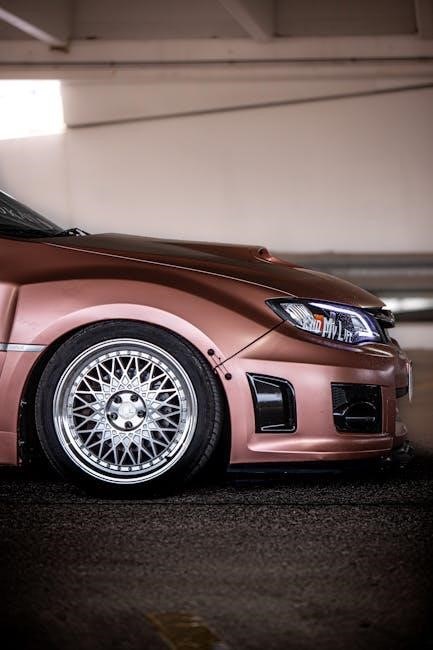
Appendix
Refer to Subaru’s official parts catalog, forums, and repair manuals for detailed specifications and diagrams. Online communities and specialty shops offer valuable resources for parts interchange.
Glossary of Terms
A guide to key terms used in Subaru parts interchange, ensuring clarity for enthusiasts and mechanics. ECU (Engine Control Unit): Manages engine functions. Boxer Engine: Subaru’s flat, horizontally opposed engine. CVT (Continuously Variable Transmission): Transmission offering infinite gear ratios. AWD (All-Wheel Drive): System powering all wheels. VIN (Vehicle Identification Number): Unique identifier for vehicle specifics. Bleeder Valve: Used in brake systems to remove air. EJ Engine: Common Subaru engine family. Turbocharger: Boosts engine performance. Intercooler: Cools turbocharged air. OEM (Original Equipment Manufacturer): Genuine Subaru parts. Aftermarket: Non-OEM parts for upgrades or repairs.
Additional Resources and References
For further exploration, explore Subaru’s official parts catalog and enthusiast forums. Websites like subaruonlineparts.com and subaruwarehousedirect.com offer genuine parts at competitive prices. Online communities such as Subaru forums provide detailed interchange guides and member experiences. YouTube channels like MrSubaru offer video guides on engine swaps and CVT troubleshooting. Subaru’s official service manuals are invaluable for technical specifications. Local dealerships and specialty shops can also assist with part compatibility. These resources ensure a well-rounded understanding of Subaru parts interchange, helping enthusiasts and mechanics alike make informed decisions.